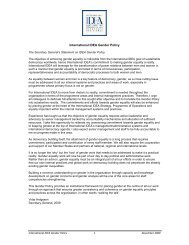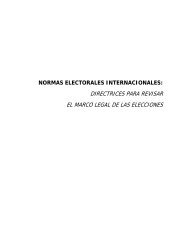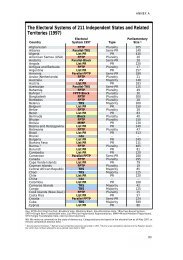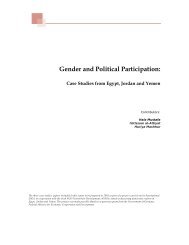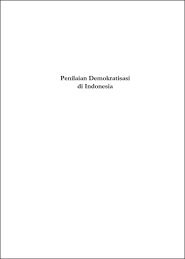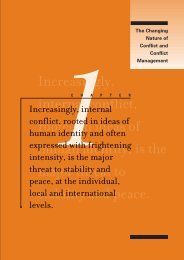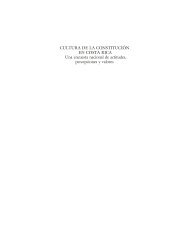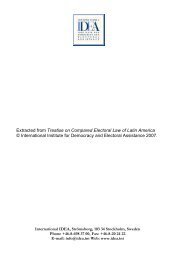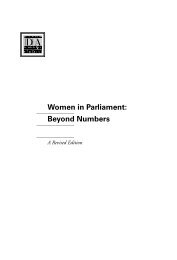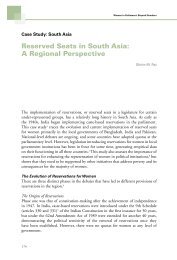The Role of State Constitutions in Protecting ... - International IDEA
The Role of State Constitutions in Protecting ... - International IDEA
The Role of State Constitutions in Protecting ... - International IDEA
Create successful ePaper yourself
Turn your PDF publications into a flip-book with our unique Google optimized e-Paper software.
<strong>The</strong> Indian constitution<br />
provides a large number <strong>of</strong><br />
exceptional arrangements<br />
...<strong>of</strong> particular <strong>in</strong>terest for<br />
Burma. Some states have<br />
certa<strong>in</strong> exceptional rights<br />
and certa<strong>in</strong> autonomous<br />
areas have been designated<br />
with<strong>in</strong> states<br />
...provid<strong>in</strong>g additional<br />
protections for m<strong>in</strong>orities.<br />
S<strong>in</strong>ce the federal constitution allows the re-arrangement <strong>of</strong> the federal<br />
distribution <strong>of</strong> power, there have been a number <strong>of</strong> reorganizations <strong>of</strong> states along<br />
l<strong>in</strong>guistic l<strong>in</strong>es. This has helped fulfill local needs and protect l<strong>in</strong>guistic<br />
m<strong>in</strong>orities. For <strong>in</strong>stance, Punjab state was split up <strong>in</strong>to Punjab, Haryana and the<br />
Union territory <strong>of</strong> Chandigar <strong>in</strong> 1966. Similarly, the states <strong>of</strong> Chhattisgarh,<br />
Jharkhand and Uttaranchal were carved out <strong>in</strong> 2000. <strong>The</strong> Union <strong>of</strong> India, which<br />
now has 28 states, divides its power between the union and the states <strong>in</strong> terms <strong>of</strong><br />
executive, legislative and f<strong>in</strong>ancial matters. However, judicial power is not divided<br />
and there is only one judicial system for both the Union and the states. <strong>The</strong><br />
Union’s exclusive legislative rights cover defense, foreign affairs, bank<strong>in</strong>g,<br />
<strong>in</strong>surance, currency and co<strong>in</strong>age, Union duties and taxes, while the state<br />
legislatures have exclusive authority over public order and police, local<br />
government, public health, sanitation, agriculture, forests, fisheries, state taxes<br />
and duties. Concurrent powers between the union and the states cover 52 items<br />
– <strong>in</strong>clud<strong>in</strong>g crim<strong>in</strong>al law and procedure, civil procedure, marriage, contracts,<br />
torts, trusts, welfare <strong>of</strong> labor, eco-social and social plann<strong>in</strong>g and education. If<br />
there are overlapp<strong>in</strong>g powers, the union’s right to exercise that power prevails.<br />
<strong>The</strong> Indian constitution provides a large number <strong>of</strong> exceptional arrangements for<br />
specific states and areas. Two <strong>of</strong> them may be <strong>of</strong> particular <strong>in</strong>terest for Burma.<br />
Some states have certa<strong>in</strong> exceptional rights and certa<strong>in</strong> autonomous areas have<br />
been designated with<strong>in</strong> states. Autonomous regions and districts allow self-rule to<br />
m<strong>in</strong>orities with<strong>in</strong> a state, provid<strong>in</strong>g additional protections for m<strong>in</strong>orities.<br />
Yadav expla<strong>in</strong>ed that <strong>in</strong>terest<strong>in</strong>gly there has been no special electoral status for any<br />
m<strong>in</strong>ority group, except for Scheduled castes and Scheduled tribes who were<br />
marg<strong>in</strong>alized before <strong>in</strong>dependence. India has been us<strong>in</strong>g the First-Pass-<strong>The</strong>-Post<br />
electoral system (FPTP) rather than the Proportional Representation system (PR)<br />
s<strong>in</strong>ce <strong>in</strong>dependence. As a result, the Muslims who are distributed th<strong>in</strong>ly<br />
throughout the country cannot vote as a bloc and their overall representation is<br />
low. Sikhs who are concentrated territorially <strong>in</strong> the Punjab have a higher<br />
representation than those Sikhs spread th<strong>in</strong>ly all over the country. Nevertheless,<br />
he claimed that the FPTP system has a unique advantage <strong>in</strong> help<strong>in</strong>g make Indian<br />
society socially cohesive. <strong>The</strong> FPTP system encourages political parties to be more<br />
representative, because they must speak to many groups to obta<strong>in</strong> power. To w<strong>in</strong><br />
elections under the FPTP system, political parties <strong>in</strong> practice feel compelled to<br />
<strong>in</strong>tegrate a variety <strong>of</strong> groups and <strong>in</strong>terests. In this sense, India’s Congress I party<br />
attempts to forge a social coalition and represents various social groups, different<br />
ideas, and different states. Another practice that helps to deepen the democratic<br />
federation is the excellent work <strong>of</strong> regional political parties which promote<br />
decentralization.<br />
Reflect<strong>in</strong>g on the nature <strong>of</strong> society and civilization, Yadav disagreed with the <strong>of</strong>ten<br />
advanced theory that H<strong>in</strong>duism per se promotes a culture <strong>of</strong> tolerance and<br />
accommodation that helps make federalism work <strong>in</strong> such a diverse society.<br />
Instead, he po<strong>in</strong>ted to the crosscutt<strong>in</strong>g social cleavages as the ma<strong>in</strong> factor <strong>in</strong><br />
4




